南方医科大学学报 ›› 2025, Vol. 45 ›› Issue (3): 603-613.doi: 10.12122/j.issn.1673-4254.2025.03.18
• • 上一篇
刘洋1,2( ), 贾亿卿2, 李程程1,2, 毛汉丁2, 刘树元2(
), 贾亿卿2, 李程程1,2, 毛汉丁2, 刘树元2( ), 单毅1,2(
), 单毅1,2( )
)
收稿日期:2024-11-06
出版日期:2025-03-20
发布日期:2025-03-28
通讯作者:
刘树元,单毅
E-mail:1316655020@qq.com;liusydoc@163.com;nghicu@163.com
作者简介:刘 洋,在读硕士研究生,E-mail: 1316655020@qq.com
基金资助:
Yang LIU1,2( ), Yiqing JIA2, Chengcheng LI1,2, Handing MAO2, Shuyuan LIU2(
), Yiqing JIA2, Chengcheng LI1,2, Handing MAO2, Shuyuan LIU2( ), Yi SHAN1,2(
), Yi SHAN1,2( )
)
Received:2024-11-06
Online:2025-03-20
Published:2025-03-28
Contact:
Shuyuan LIU, Yi SHAN
E-mail:1316655020@qq.com;liusydoc@163.com;nghicu@163.com
摘要:
目的 研究右美托咪定(DEX)对于热打击诱导人骨骼肌细胞(HSKMC)胀亡的保护作用及可能机制。 方法 体外培养HSKMC,热打击组(HS组)将细胞置于43 ℃的水浴锅中热打击4 h,构建细胞胀亡模型,设置对照组、HS组、30 μmol/L DEX+HS组、ML385+30 μmol/L DEX+HS组、si-Nrf2+HS组、si-Nrf2+30 μmol/L DEX+HS组。通过CCK-8法检测细胞活力,透射电子显微镜观察细胞超微结构,Annexin V-FITC/PI免疫荧光流式细胞术检测细胞胀亡和细胞凋亡,使用谷胱甘肽(GSH)和GSH-px试剂盒检测细胞中GSH及GSH-px含量,TBA法检测丙二醛(MDA),比色法检测乳酸脱氢酶(LDH)、超氧歧化酶(SOD)、三磷酸腺苷(ATP)表达水平,ELISA法检测肿瘤坏死因子(TNF)-α、白介素(IL)-6、IL-1β水平,qRT-PCR及Western blotting法检测porimin、caspase-3、Nrf2、p-Nrf2、HO-1、NQO1等蛋白表达水平变化,荧光探针法检测细胞内活性氧(ROS),JC-1荧光染色法检测线粒体膜电位损伤。 结果 与对照组相比,HS组细胞和细胞器肿胀、胞质内空泡化明显,符合胀亡表现,细胞活力下降,细胞双阳性细胞率(Annexin-V+/PI+)、porimin蛋白表达量增加(P<0.05),caspase-3蛋白在各组间的差异无统计学意义(P>0.05),ROS、MDA、LDH、TNF-α、IL-6和IL-1β的含量增多(P<0.05),ATP、线粒体膜电位、GSH、GSH- px和SOD水平降低(P<0.05)。与HS组相比,30 μmol/L DEX+HS组细胞损伤减轻,细胞活力升高,细胞双阳性细胞率下降(P<0.05),ROS、MDA、LDH、TNF-α、IL-6和IL-1β的含量下降(P<0.05),ATP、线粒体膜电位、GSH、GSH- px和SOD含量升高(P<0.05),Nrf2、p-Nrf2、HO-1和NQO1蛋白表达升高(P<0.05)。与30 μmol/L DEX+HS组相比,经ML385或si-Nrf2干预后,DEX对HSKMC细胞的保护作用减弱(P<0.05)。 结论 热打击诱导人骨骼肌细胞发生胀亡,DEX抑制热打击诱导的胀亡,可能机制是激活Nrf2/HO-1信号通路减轻HSKMC的氧化损伤以及抑制炎症因子分泌。
刘洋, 贾亿卿, 李程程, 毛汉丁, 刘树元, 单毅. 右美托咪定通过激活Nrf2/HO-1通路减轻热应激诱导的人骨骼肌细胞胀亡[J]. 南方医科大学学报, 2025, 45(3): 603-613.
Yang LIU, Yiqing JIA, Chengcheng LI, Handing MAO, Shuyuan LIU, Yi SHAN. Dexmedetomidine attenuates heat stress-induced oncosis in human skeletal muscle cells by activating the Nrf2/Ho-1 pathway[J]. Journal of Southern Medical University, 2025, 45(3): 603-613.
| Target name | Primer sequences | |
|---|---|---|
| Actin | F | TCCTCCTGAGCGCAAGTACTCC |
| R | CATACTCCTGCTTGCTGATCCAC | |
| Porimin | F | CTCGGAACAATGGGACTCGG |
| R | TATGTTTGCAGATGCCGCC | |
| Caspase-3 | F | ATGACATCTCGGTCTGGTA |
| R | CTTTAGAAACATCACGCATC | |
| Nrf2 | F | TCAGCGACGGAAAGAGTATGA |
| R | CCACTGGTTTCTGACTGGATGT | |
| HO-1 | F | CCTTCCCCAACATTGCCAGT |
| R | CTTGGCCTCTTCTATCACCCTC | |
| NQO1 | F | GCTGGTTTGAGCGAGTGTTC |
| R | CTGCCTTCTTACTCCGGAAGG | |
表1 引物序列
Tab.1 The sequences of primers
| Target name | Primer sequences | |
|---|---|---|
| Actin | F | TCCTCCTGAGCGCAAGTACTCC |
| R | CATACTCCTGCTTGCTGATCCAC | |
| Porimin | F | CTCGGAACAATGGGACTCGG |
| R | TATGTTTGCAGATGCCGCC | |
| Caspase-3 | F | ATGACATCTCGGTCTGGTA |
| R | CTTTAGAAACATCACGCATC | |
| Nrf2 | F | TCAGCGACGGAAAGAGTATGA |
| R | CCACTGGTTTCTGACTGGATGT | |
| HO-1 | F | CCTTCCCCAACATTGCCAGT |
| R | CTTGGCCTCTTCTATCACCCTC | |
| NQO1 | F | GCTGGTTTGAGCGAGTGTTC |
| R | CTGCCTTCTTACTCCGGAAGG | |
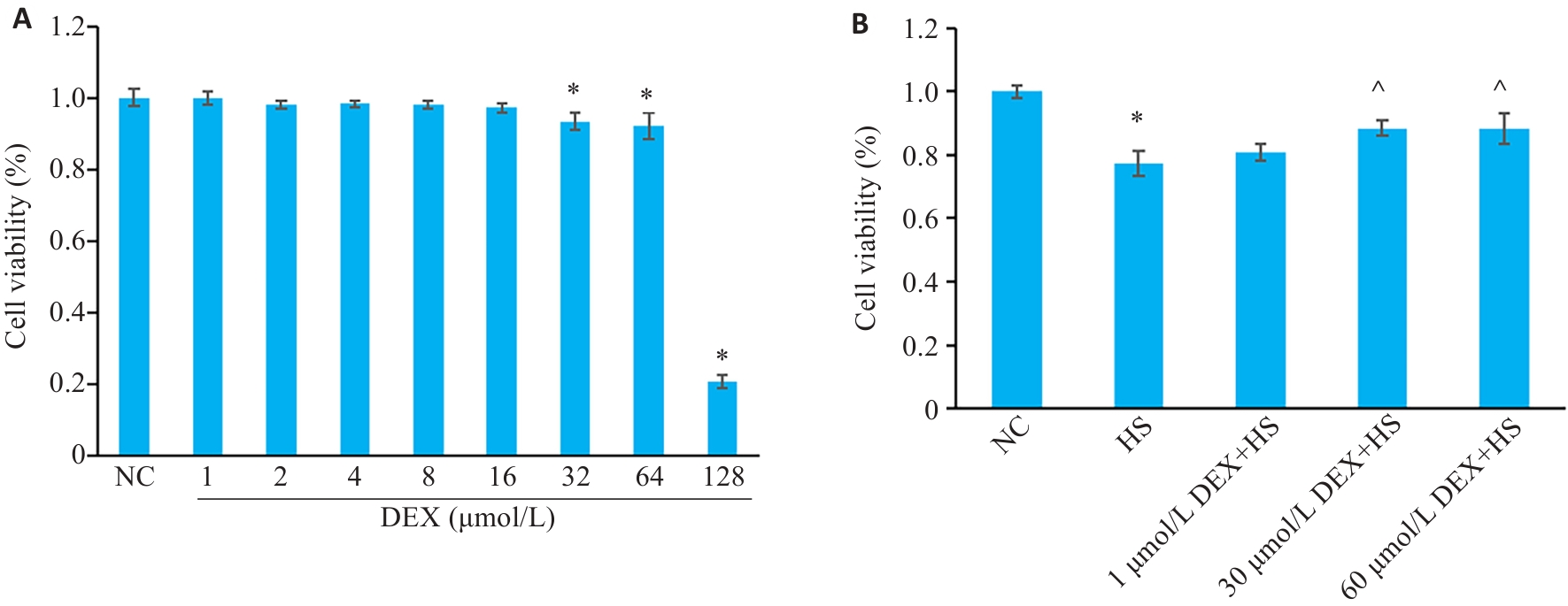
图2 DEX用药浓度筛选
Fig.2 Screening of dexmedetomidine (DEX) dosing concentrations. A: Effects of different concentrations of DEX on HSKMC viability. *P<0.05 vs NC group (n=6). B: Effect of DEX (1, 30 and 60 μmol/L) on viability of HSKMC cells after heat stress. *P<0.05 vs NC group; ^P<0.05 vs HS group (n=6).
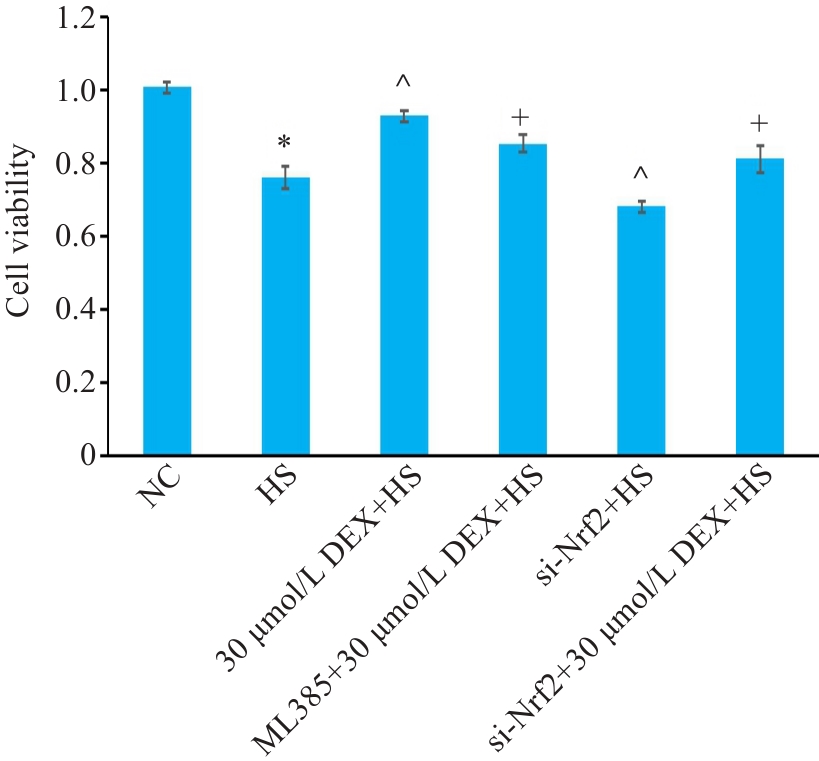
图3 DEX对各组HSKMC细胞活力的影响
Fig.3 Effect of DEX on viability of HSKMC cells in each group. *P<0.05 vs NC group; ^P<0.05 vs HS group; +P<0.05 vs 30 μmol/L DEX+HS group (n=6).
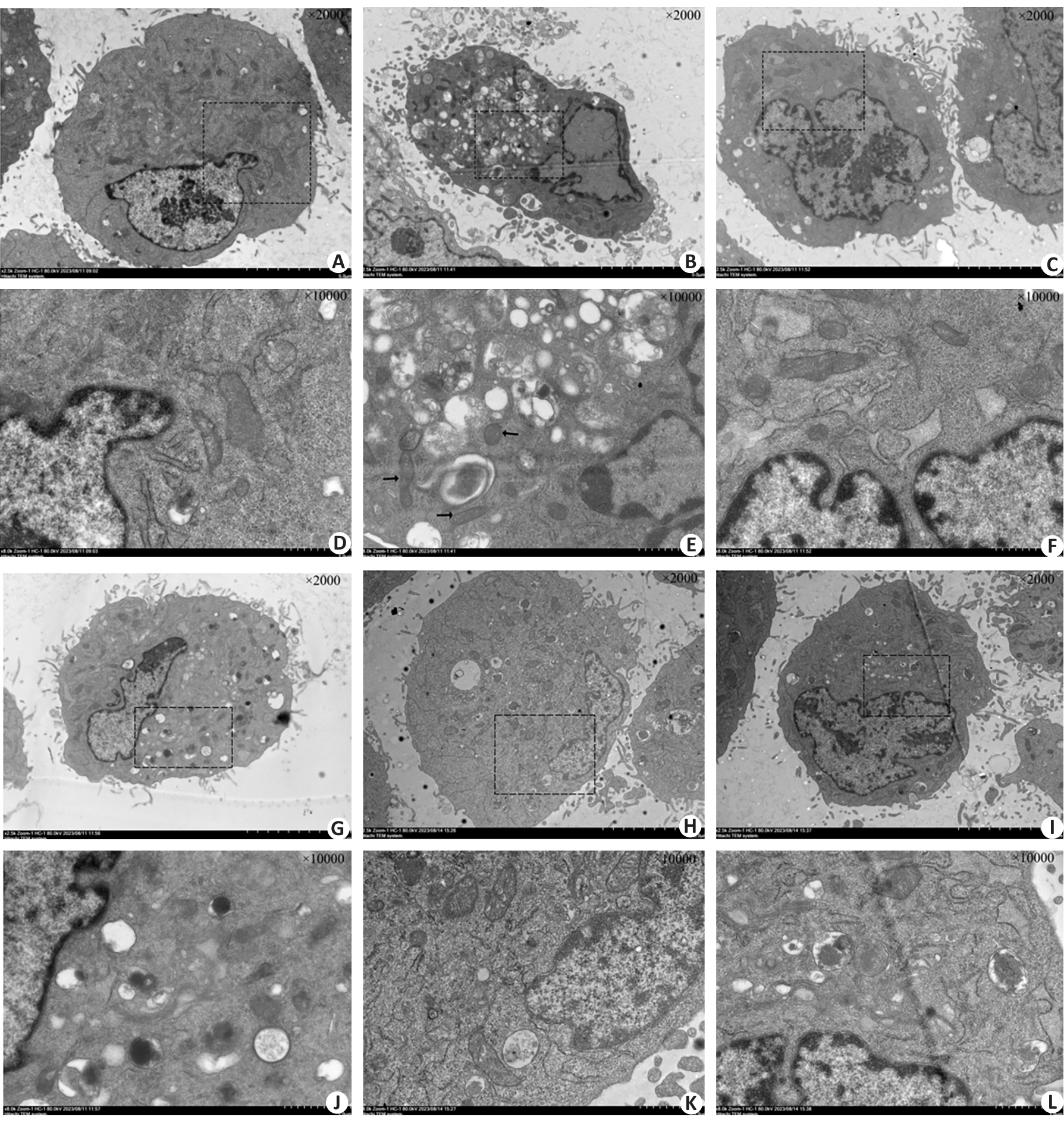
图4 透射电子显微镜观察HSKMC结构变化
Fig.4 Observation of structural changes of HSKMCs under transmission electron microscope. Black arrows indicated mitochondrial swelling after heat stress. A: NC group (Original magnification: ×2000). B: HS group (×2000), C: 30 μmol/L DEX+HS group (×2000). D: NC group (×10 000). E: HS group (×10 000). F: 30 μmol/L DEX+HS group (×10 000). G: ML385+30 μmol/L DEX+HS group (×2000) . H: si-Nrf2+HS group (×2000). I: si-Nrf2+30 μmol/L DEX+HS group (×2000). J: ML385+30 μmol/L DEX+HS group (×10 000). K: si-Nrf2+HS group (×10 000) . L: si-Nrf2+30 μmol/L DEX+HS group (×10 000).
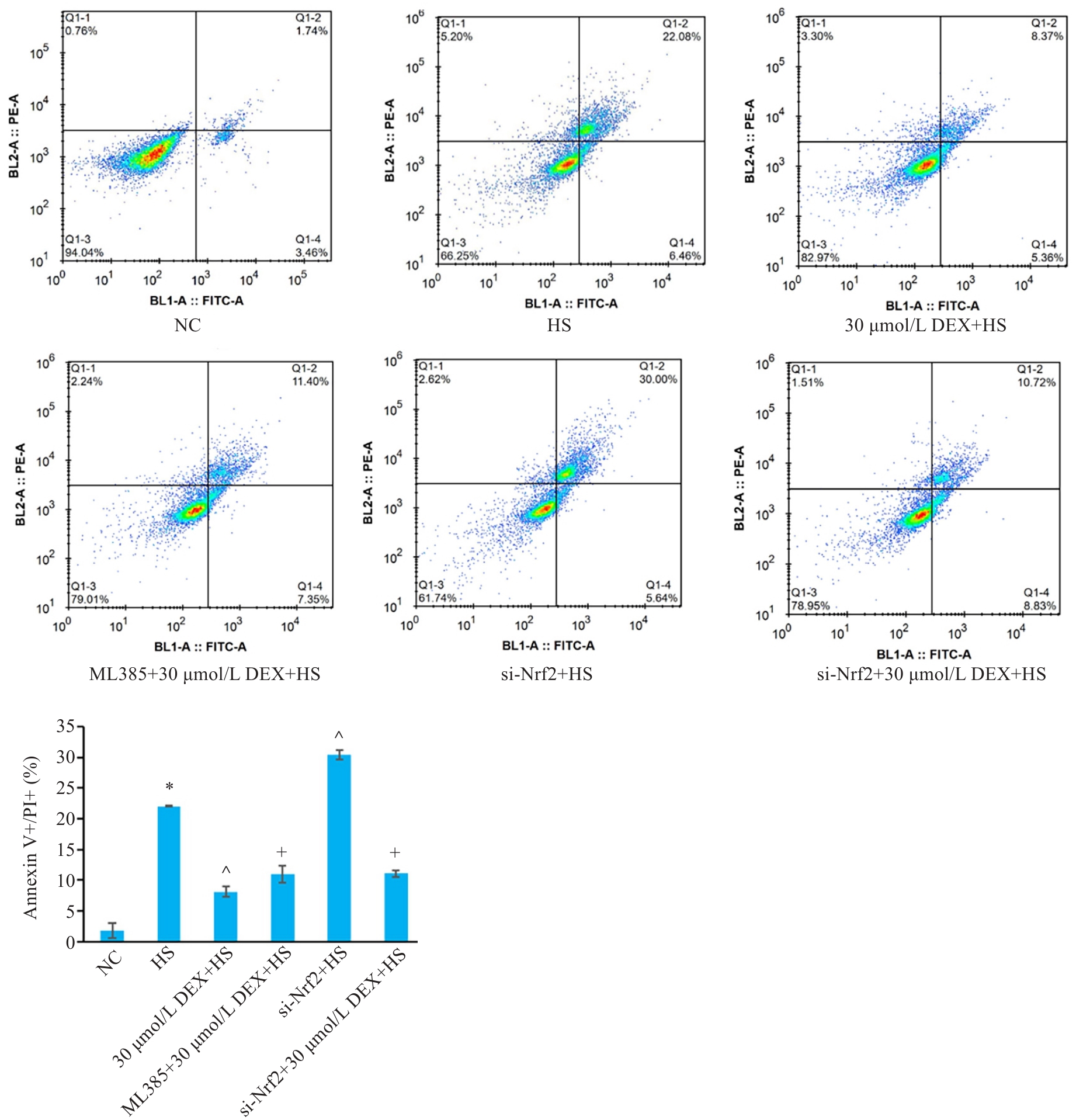
图5 各组细胞双阳性细胞率(Annexin-V+/PI+)比较
Fig.5 Comparison of Annexin-V+/PI+ double-positive cell rate in each group. *P<0.05 vs NC group; ^P<0.05 vs HS group; +P<0.05 vs 30 μmol/L DEX+HS group (n=3).
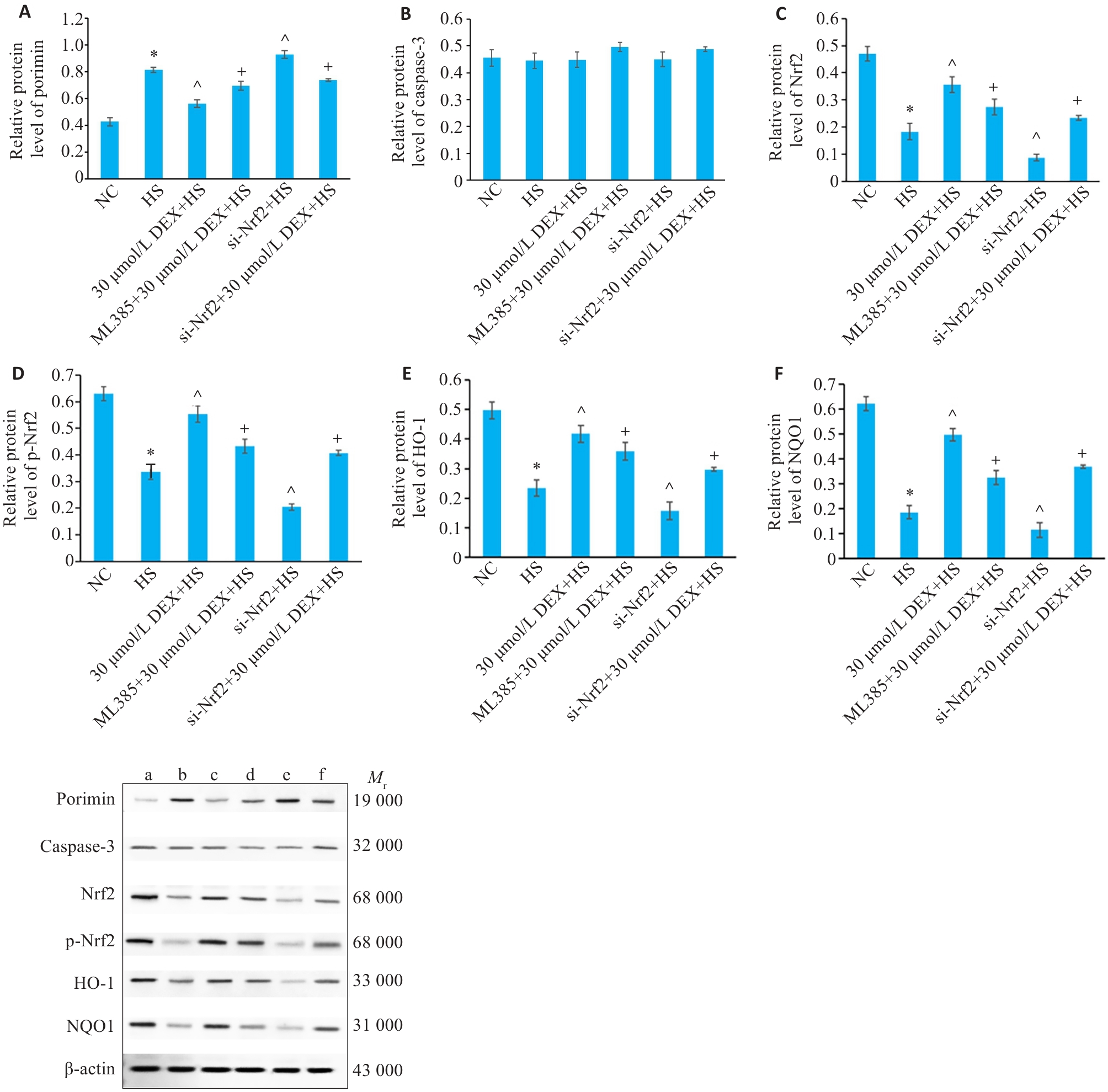
图6 各组HSKMC中porimin(A)、caspase-3(B)、Nrf2(C)、p-Nrf2(D)、HO-1(E)和NQO1(F)蛋白表达量
Fig.6 Protein expression levels of porimin (A), caspase-3 (B), Nrf2 (C), p-Nrf2 (D), HO-1 (E), and NQO1 (F) in HSKMCs in each group. *P<0.05 vs NC group; ^P<0.05 vs HS group; +P<0.05 vs 30 μmol/L DEX+HS group (Mean±SD, n=3). a: NC group; b: HS group; c: 30 μmol/L DEX+HS group; d: ML385+30 μmol/L DEX+HS group; e: si-Nrf2+HS group; f: si-Nrf2+DEX +HS group.
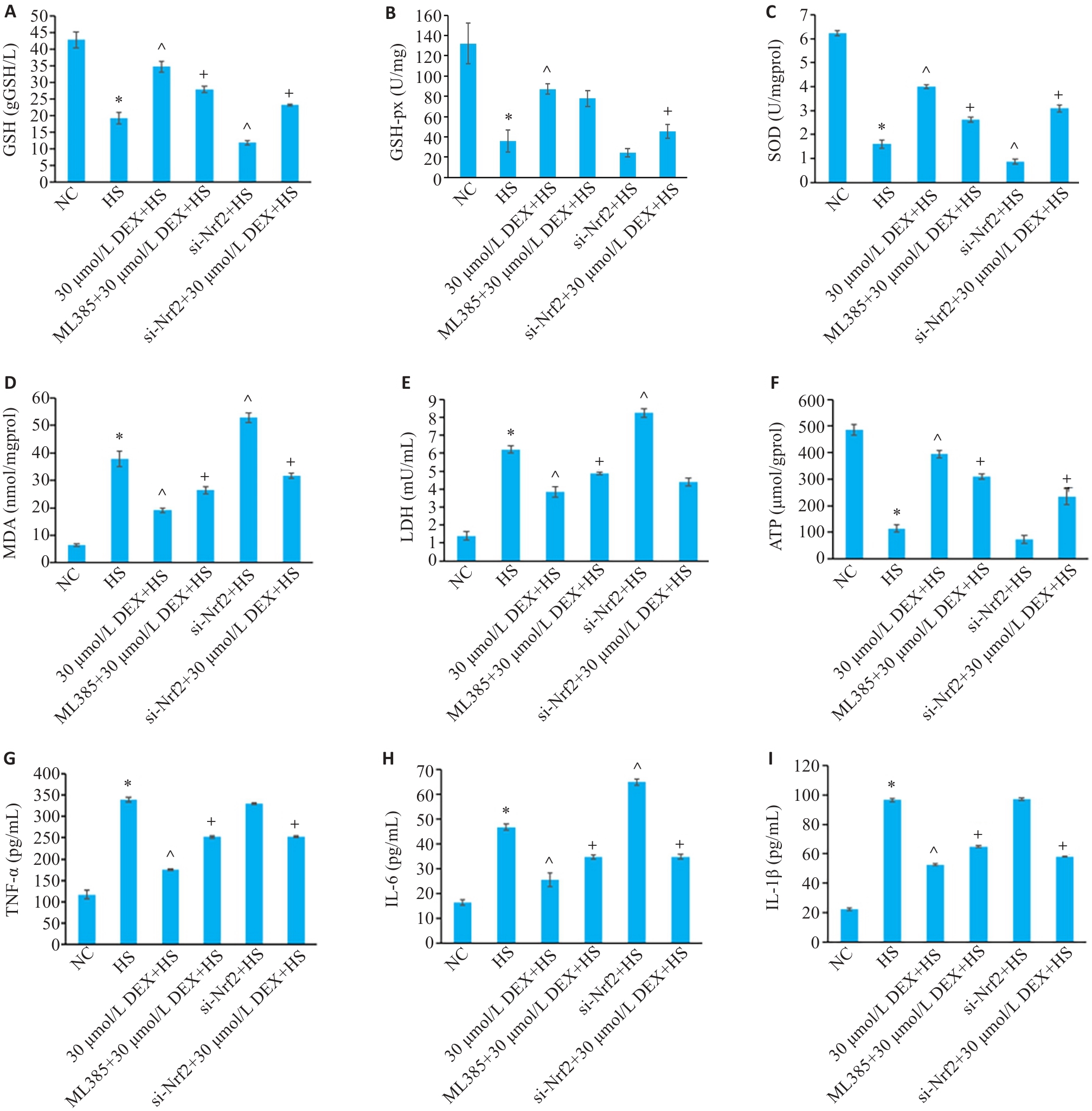
图7 各组HSKMC中GSH(A)、GSH- px(B)、SOD(C)、MDA(D)、LDH(E)、ATP(F)、TNF-α(G)、IL-6(H)和IL-1β(I)水平
Fig.7 GSH (A), GSH-px (B), SOD (C), MDA (D), LDH (E), ATP (F), TNF-α (G), IL-6 (H), and IL-1β (I) levels in HSKMC in each group. *P<0.05 vs NC group; ^P<0.05 vs HS group; +P<0.05 vs 30 μmol/L DEX+HS group (Mean±SD, n=3).
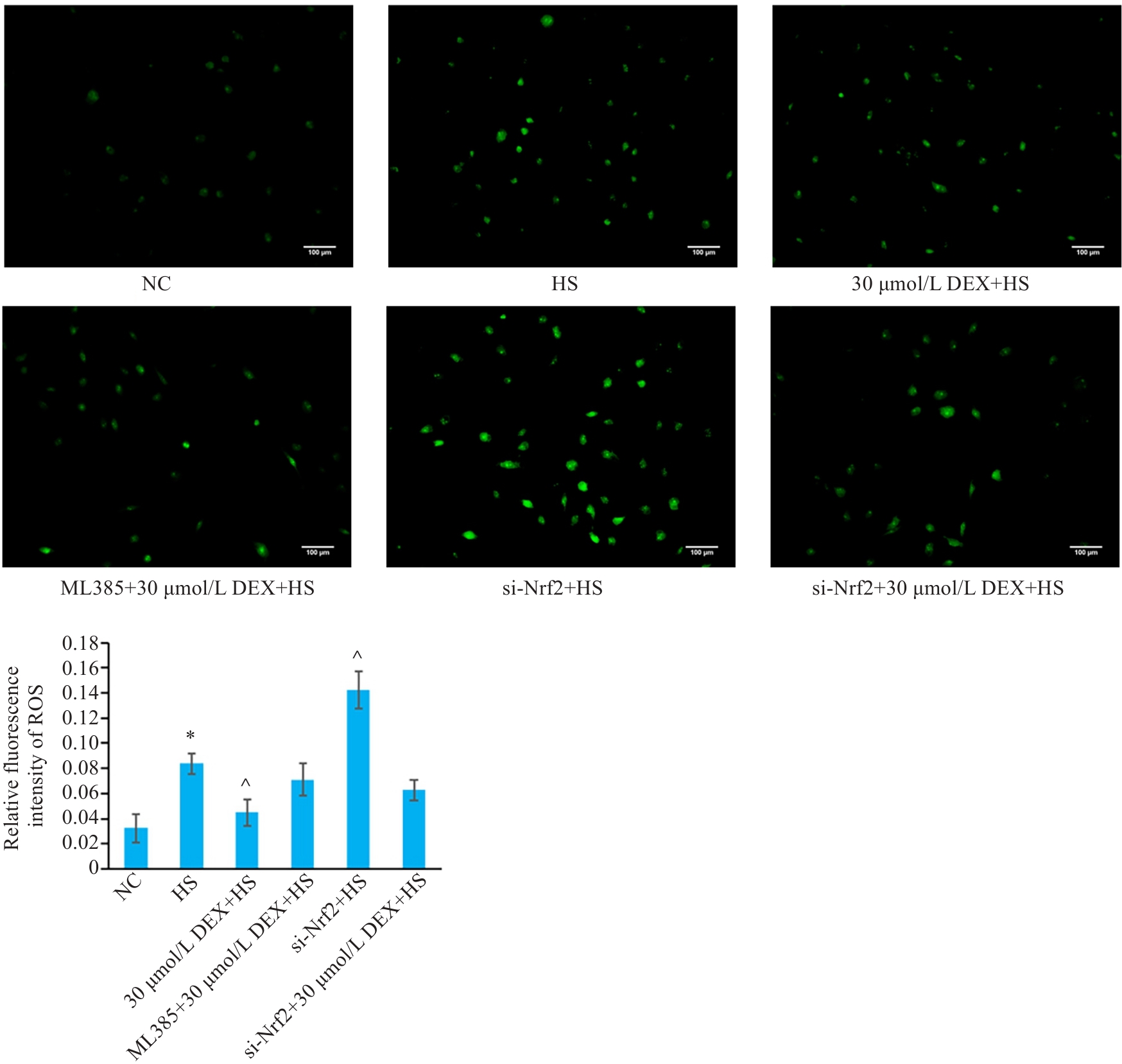
图8 各组HSKMC中ROS荧光检测及荧光强度检测
Fig.8 ROS fluorescence detection and fluorescence intensity in HSKMCs in each group (×100). *P<0.05 vs NC group; ^P<0.05 vs HS group (Mean±SD, n=3).
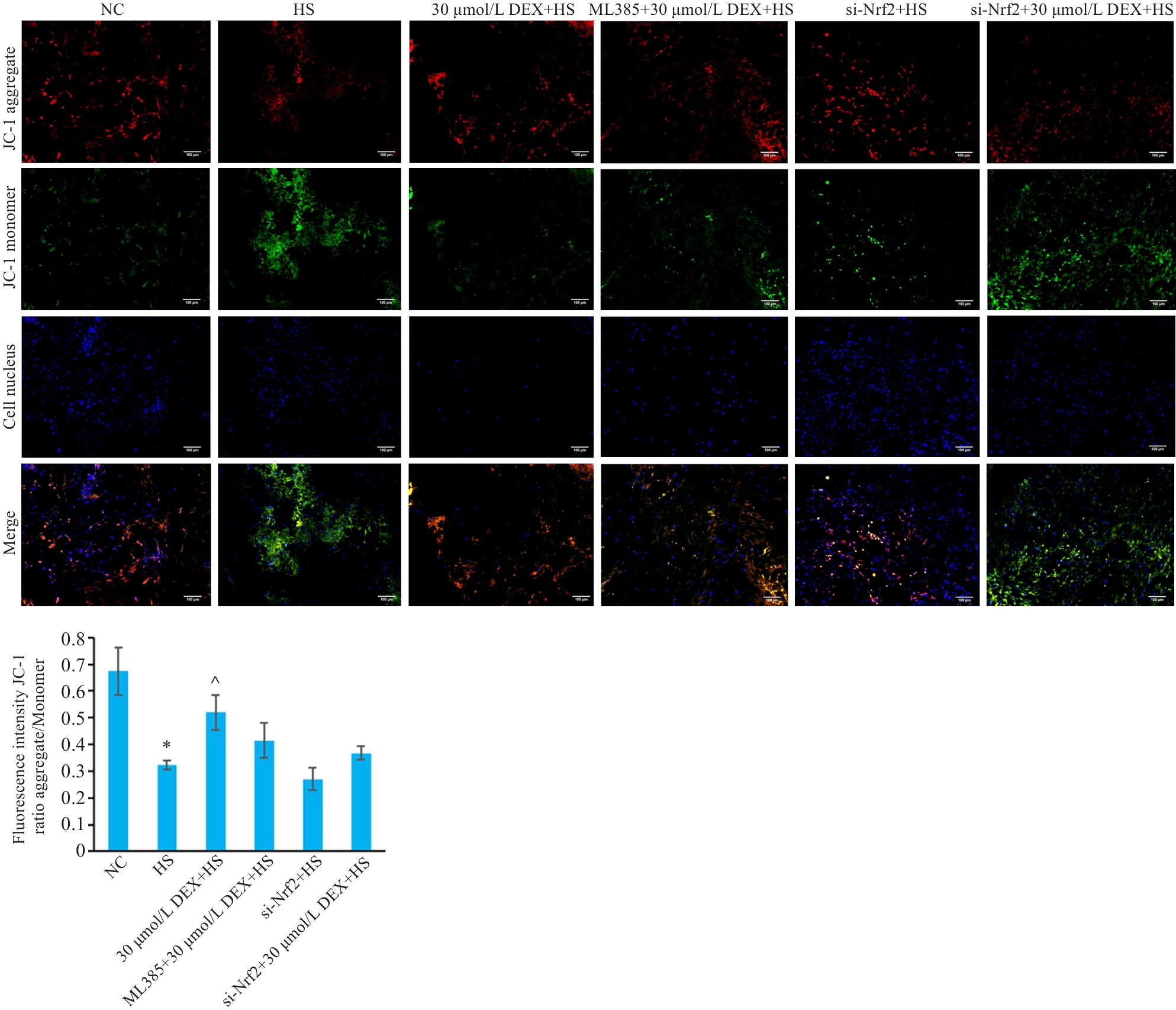
图9 各组HSKMC线粒体荧光及膜电位检测
Fig.9 HSKMC mitochondrial fluorescence and membrane potential assay in each group (×100). *P<0.05 vs NC group; ^P<0.05 vs HS group (Mean±SD, n=3).
| 1 | Torres PA, Helmstetter JA, Kaye AM, et al. Rhabdomyolysis: pathogenesis, diagnosis, and treatment[J]. Ochsner J, 2015, 15(1): 58-69. |
| 2 | Zutt R, van der Kooi AJ, Linthorst GE, et al. Rhabdomyolysis: review of the literature[J]. Neuromuscul Disord, 2014, 24(8): 651-9. |
| 3 | Cabral BMI, Edding SN, Portocarrero JP, et al. Rhabdomyolysis[J]. Dis Mon, 2020, 66(8): 101015. |
| 4 | Peters AA, Jamaludin SN, Yapa KS, et al. Oncosis and apoptosis induction by activation of an overexpressed ion channel in breast cancer cells[J]. Oncogene, 2017, 36(46): 6490-500. |
| 5 | Zheng JY, Tan HL, Matsudaira PT, et al. Excess reactive oxygen species production mediates monoclonal antibody-induced human embryonic stem cell death via oncosis[J]. Cell Death Differ, 2017, 24(3): 546-58. |
| 6 | Sun YX, Yu J, Liu XR, et al. Oncosis-like cell death is induced by berberine through ERK1/2-mediated impairment of mitochondrial aerobic respiration in gliomas[J]. Biomed Pharmacother, 2018, 102: 699-710. |
| 7 | Liu XM, Chen QH, Hu Q, et al. Dexmedetomidine protects intestinal ischemia-reperfusion injury via inhibiting p38 MAPK cascades[J]. Exp Mol Pathol, 2020, 115: 104444. |
| 8 | Weerink MAS, Struys MMRF, Hannivoort LN, et al. Clinical pharmacokinetics and pharmacodynamics of dexmedetomidine[J]. Clin Pharmacokinet, 2017, 56(8): 893-913. |
| 9 | Tian L, Liu Q, Wang X, et al. Fighting ferroptosis: Protective effects of dexmedetomidine on vital organ injuries[J]. Life Sci, 2024, 354: 122949. |
| 10 | Bao NR, Tang B. Organ-protective effects and the underlying mechanism of dexmedetomidine[J]. Mediators Inflamm, 2020, 2020: 6136105. |
| 11 | 李程程, 刘 洋, 毛汉丁, 等. 右美托咪定通过肾上腺素能α2受体调控NLRP3/IL-1β通路缓解劳力性热射病相关性横纹肌溶解[J/OL]. 解放军医学杂志, 2024: 1-14. |
| 12 | Qi YJ, Fu S, Pei DG, et al. Luteolin attenuated cisplatin-induced cardiac dysfunction and oxidative stress via modulation of Keap1/Nrf2 signaling pathway[J]. Free Radic Res, 2022, 56(2): 209-21. |
| 13 | Ulasov AV, Rosenkranz AA, Georgiev GP, et al. Nrf2/Keap1/ARE signaling: towards specific regulation[J]. Life Sci, 2022, 291: 120111. |
| 14 | D’Arcy MS. Cell death: a review of the major forms of apoptosis, necrosis and autophagy[J]. Cell Biol Int, 2019, 43(6): 582-92. |
| 15 | Lecoeur H, Prévost MC, Gougeon ML. Oncosis is associated with exposure of phosphatidylserine residues on the outside layer of the plasma membrane: a reconsideration of the specificity of the annexin V/propidium iodide assay[J]. Cytometry, 2001, 44(1): 65-72. |
| 16 | Zhou X, Sun WJ, Wang WM, et al. Artesunate inhibits the growth of gastric cancer cells through the mechanism of promoting oncosis both in vitro and in vivo [J]. Anticancer Drugs, 2013, 24(9): 920-7. |
| 17 | Duanghathaipornsuk S, Farrell EJ, Alba-Rubio AC, et al. Detection technologies for reactive oxygen species: fluorescence and electrochemical methods and their applications[J]. Biosensors, 2021, 11(2): 30. |
| 18 | 豆春丽. ROS介导线粒体功能障碍在热应激骨骼肌细胞胀亡中机制研究[D]. 广州: 广州中医药大学, 2020. |
| 19 | Peiris AN, Jaroudi S, Noor R. Heat stroke[J]. JAMA, 2017, 318(24): 2503. |
| 20 | Kodadek L, Carmichael Ii SP, Seshadri A, et al. Rhabdomyolysis: an American association for the surgery of trauma critical care committee clinical consensus document[J]. Trauma Surg Acute Care Open, 2022, 7(1): e000836. |
| 21 | Yue RC, Hu HX, Yiu KH, et al. Lycopene protects against hypoxia/reoxygenation-induced apoptosis by preventing mitochondrial dysfunction in primary neonatal mouse cardiomyocytes[J]. PLoS One, 2012, 7(11): e50778. |
| 22 | Chi XJ, Zhang R, Shen N, et al. Sulforaphane reduces apoptosis and oncosis along with protecting liver injury-induced ischemic reperfusion by activating the Nrf2/ARE pathway[J]. Hepatol Int, 2015, 9(2): 321-9. |
| 23 | Weerasinghe P, Maximilian Buja L. Oncosis: an important non-apoptotic mode of cell death[J]. Exp Mol Pathol, 2012, 93(3): 302-8. |
| 24 | Trump BF, Berezesky IK, Chang SH, et al. The pathways of cell death: oncosis, apoptosis, and necrosis[J]. Toxicol Pathol, 1997, 25(1): 82-8. |
| 25 | Wang YP, Gao WQ, Shi XY, et al. Chemotherapy drugs induce pyroptosis through caspase-3 cleavage of a gasdermin[J]. Nature, 2017, 547(7661): 99-103. |
| 26 | Ge Y, Cai YM, Bonneau L, et al. Inhibition of cathepsin B by caspase-3 inhibitors blocks programmed cell death in Arabidopsis [J]. Cell Death Differ, 2016, 23(9): 1493-501. |
| 27 | 豆春丽, 袁芳芳, 刘 斌, 等. 热打击诱导骨骼肌细胞胀亡而非凋亡[J]. 解放军医学杂志, 2020, 45(10): 1047-51. |
| 28 | Wu C, Chen RL, Wang Y, et al. Acacetin alleviates myocardial ischaemia/reperfusion injury by inhibiting oxidative stress and apoptosis via the Nrf-2/HO-1 pathway[J]. Pharm Biol, 2022, 60(1): 553-61. |
| 29 | Park WH. Antiapoptotic effects of caspase inhibitors on H2O2-treated lung cancer cells concerning oxidative stress and GSH[J]. Mol Cell Biochem, 2018, 441(1/2): 125-34. |
| 30 | Zhang Q, Dong XW, Xia JY, et al. Obestatin plays beneficial role in cardiomyocyte injury induced by ischemia-reperfusion in vivo and in vitro [J]. Med Sci Monit, 2017, 23: 2127-36. |
| 31 | Yilmaz Y, Tumkaya L. Effects of hyperbaric oxygen and iloprost on intestinal ischemia-reperfusion induced acute lung injury[J]. Ann Surg Treat Res, 2019, 96(1): 34-40. |
| 32 | Yang L, Xing GL, Wang L, et al. Acute kidney injury in China: a cross-sectional survey[J]. Lancet, 2015, 386(10002): 1465-71. |
| 33 | Lankadeva YR, Ma S, Iguchi N, et al. Dexmedetomidine reduces norepinephrine requirements and preserves renal oxygenation and function in ovine septic acute kidney injury[J]. Kidney Int, 2019, 96(5): 1150-61. |
| 34 | Yao H, Chi XJ, Jin Y, et al. Dexmedetomidine inhibits TLR4/NF-κB activation and reduces acute kidney injury after orthotopic autologous liver transplantation in rats[J]. Sci Rep, 2015, 5: 16849. |
| 35 | Kopacz A, Kloska D, Forman HJ, et al. Beyond repression of Nrf2: an update on Keap1[J]. Free Radic Biol Med, 2020, 157: 63-74. |
| [1] | 张方圆, 刘刚. 右美托咪定通过激活Nrf2/HO-1/GPX4通路抑制肾小管上皮细胞的铁死亡[J]. 南方医科大学学报, 2024, 44(6): 1135-1140. |
| [2] | 苏雨薇, 孙 闻, 王 迪, 董钰妍, 丁 莹, 徐龙河, 刘永哲. 右美托咪定不能降低腹腔镜下根治性肾切除术后急性和慢性肾脏病的发病率:基于倾向性评分匹配法[J]. 南方医科大学学报, 2023, 43(4): 654-659. |
| [3] | 欧 毅, 刘 刚, 殷凤伟, 杨 杨, 张方圆. 乌司他丁联合右美托咪定对肝脏缺血再灌注损伤起保护作用:基于80例肝癌合并肝硬化行腹腔镜肝切除术患者[J]. 南方医科大学学报, 2022, 42(12): 1832-1838. |
| [4] | 韩 冰, 陈梦婷, 杨传铭, 李晓红. 右美托咪定预处理通过抑制NLRP3炎性小体激活减轻大鼠肠缺血再灌注诱导的急性肺损伤[J]. 南方医科大学学报, 2021, 41(12): 1857-1863. |
| [5] | 龚 拯, 龙小毛, 韦慧君, 唐 莹, 栗 俊, 马 利, 余 军. 右美托咪定联合肺保护性通气策略可减轻单肺通气食管癌根治术患者的肺损伤[J]. 南方医科大学学报, 2020, 40(07): 1013-1017. |
| [6] | 刘 刚,门运政,童旭辉,王雪如,胡 淼,姜牧君,孙志鹏,董淑英. 线粒体融合与裂变在右美托咪定减轻小鼠脑缺血再灌注损伤中的作用及其机制[J]. 南方医科大学学报, 2020, 40(04): 463-468. |
| [7] | 曹舸,张尔永. 右美托咪定对体外循环缺血再灌注损伤肺组织保护作用的相关信号通路[J]. 南方医科大学学报, 2019, 39(08): 980-. |
| [8] | 张津玮,张小宝,钱海涛,崔吉正,顾小萍. 右美托咪定可减轻大鼠胫骨骨折手术所致的术后认知功能障碍[J]. 南方医科大学学报, 2019, 39(03): 292-. |
| [9] | 方四通,陈勇,姚鹏,李依玲,杨玉军,徐国海. 右美托咪定可能通过SIRT1信号通路减轻老龄大鼠的术后认知功能障碍[J]. 南方医科大学学报, 2018, 38(09): 1071-. |
| [10] | 李双凤,欧阳碧山,赵鑫,王亚平. 右美托咪定对奥沙利铂致神经性疼痛的镇痛作用及机制[J]. 南方医科大学学报, 2018, 38(07): 836-. |
| [11] | 郭远波,徐金东,纪雪霞,张建杏,梁杰贤,周国斌. 右美托咪定对行肺癌根治术的患者围手术期炎症及肺功能保护作用的影响[J]. 南方医科大学学报, 2017, 37(12): 1673-. |
| [12] | 杨世辉,孙维国,李永乐,陈祥楠,漆冬梅,孙艺娟. 不同剂量右美托咪定复合罗哌卡因臂丛阻滞用于小儿多指手术的效果比较[J]. 南方医科大学学报, 2017, 37(06): 833-. |
| [13] | 张卫东,张浩,汪海,张娜,杜春彦,余军,冯泽国. 右美托咪定对谷氨酸所致PC12细胞损伤的保护作用及其机制[J]. 南方医科大学学报, 2017, 37(02): 150-. |
| [14] | 斯妍娜,韩流,张媛,陈利海,徐亚杰,孙凡,潘笑笑,曾令清,鲍红光. 超声造影评价右美托咪定对兔肾缺血/再灌注损伤时微循环灌注的影响[J]. 南方医科大学学报, 2016, 36(05): 628-. |
| [15] | 梁芳果,欧阳铭文,王海棠. BIS反馈闭环路靶控输注右美托咪定可减少丙泊酚用量[J]. 南方医科大学学报, 2015, 35(10): 1497-. |
| 阅读次数 | ||||||
|
全文 |
|
|||||
|
摘要 |
|
|||||